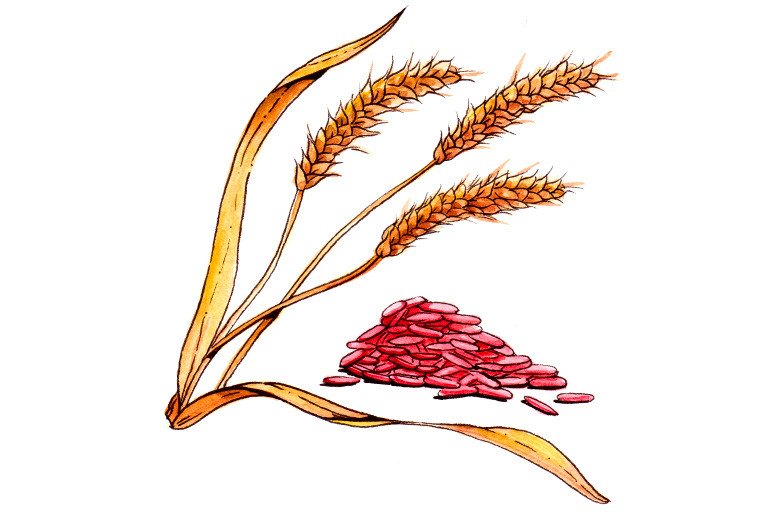
Common Names
- Hong qu
- Monascus
- Red yeast
- Beni-koji
- Monacolin K
For Patients & Caregivers
Tell your healthcare providers about any dietary supplements you’re taking, such as herbs, vitamins, minerals, and natural or home remedies. This will help them manage your care and keep you safe.
Red yeast rice appears to lower blood cholesterol and triglyceride levels, but it is not certain whether these products are safe to use.
Red yeast rice is a traditional Chinese medicinal product that also has culinary uses. It is made by culturing rice with specific strains of yeast. It is also marketed as a dietary supplement to reduce cholesterol and other fats in the blood. One of its constituents, monacolin K, also known as lovastatin, is an active ingredient in the cholesterol-lowering drug, Mevacor®. The drug works by inhibiting an enzyme essential for the creation of cholesterol in the body. Therefore, it is assumed that red yeast rice works through a similar mechanism.
Even though red yeast rice appears to reduce blood fats, it is not certain whether these products are safe. Some may contain a harmful contaminant or have side effects similar to certain cholesterol-lowering drugs. There have also been several case reports of adverse effects, so patients should discuss any use of this product with their healthcare provider.
- To lower high cholesterol
A few clinical trials show that the use of red yeast rice can reduce cholesterol and triglyceride levels in the blood, but it is not certain whether these products are safe.
- Stomach ache
- Dizziness
- Flatulence
- Heartburn
- Muscular disease resulting in muscle weakness
Case reports
- Allergic reaction
- Elevated liver enzymes
- Liver injury, hepatitis
- Unexpected high cholesterol
- Skeletal muscle weakness and damage
- Erectile dysfunction
Patient Warnings:
- Citrinin, a toxic fermentation byproduct, has been found in a number of red yeast rice preparations.
- Grapefruit juice may increase the effects of red yeast rice.
Do Not Take if:
You are taking cholesterol-lowering drugs: Red yeast rice supplements contain variable amounts of monacolin K, the active ingredient in lovostatin. Side effects and interactions can be comparable to statin drugs, and long-term safety data is lacking.
You are taking CYP450 3A4 or P-glycoprotein substrate drugs: Lab studies show that red yeast rice extracts may affect drugs metabolized by these enzymes. Clinical relevance has yet to be determined.
Special Point:
The U.S. Food and Drug Administration declared that the dietary supplement Cholestin, manufactured by Pharmanex, cannot be marketed as a dietary supplement because it contained lovastatin, a prescription drug.
For Healthcare Professionals
Used in China as food and medicine for thousands of years, red yeast rice is the fermented product of the fungus, Monascus purpureus, grown on rice. It was first marketed as a dietary supplement in the United States by Pharmanex under the trade name Cholestin (1). The active constituent, monacolin K, is the same as lovastatin, an active ingredient in the cholesterol-lowering drug (2). A number of clinical trials have demonstrated effectiveness of red yeast rice preparations in reducing cholesterol levels in hyperlipidemic patients (3) (4) (5) (14) (15) (16) (17) (32), but meta-analyses are mixed on whether it is safe (24) (25) (33), with one citing a lack of regulation and standardized formulations. One of the extracts tested also did not lower blood pressure in hypertensive patients (20). In another study, co-supplementation with Coenzyme Q10 was found to be associated with improved LDL-cholesterolemia and endothelial reactivity in moderately hypercholesterolemic subjects (22).
It is important to note that several preparations of red rice yeast contain citrinin, a toxic fermentation byproduct (6).
- High cholesterol
Components such as citrinin, monacolines and monankarin, and monascopyridines have been isolated from red yeast rice (10). Fermentation products are standardized to contain 0.4% 3-hydroxy-3-methylglutaryl coenzyme A (HMG-CoA) reductase inhibitors. HMG-CoA reductase is the rate-limiting enzyme in endogenous cholesterol biosynthesis (1). The principal HMG-CoA reductase inhibitor is monacolin K, also known as lovastatin (11).
Stomach ache (3), heartburn, dizziness and flatulence (7), liver injury and myopathy (21) (23).
Case reports
- Anaphylaxis: In a 26-year-old man (8).
- Hypertransaminasemia: In a 63-year-old woman following use of Equisterol, an over-the-counter lipid-lowering product containing guggulsterol and red yeast rice extract, for 6 months. Symptoms normalized after product was discontinued (18).
- Severe hepatitis: In a 62-year-old woman after use of red yeast rice capsules for 4 months. Condition improved after product was discontinued (19).
- Acute liver injury: In a 64-year-old woman not on medications, and 6 weeks after starting a red yeast rice supplement to decrease cholesterol (27).
- Paradoxical hypercholesterolemia: On routine screening in a 23-year-old man, attributed to downregulation of cholesteryl ester transfer protein with the use of red yeast rice extract (28). Symptoms disappeared after product discontinuation.
- Rhabdomyolysis: In a 28-year-old renal transplant recipient (12).
- Myasthenia gravis: Associated with use of red yeast rice supplements (29).
- Erectile dysfunction: In a 39-year-old male patient who used red yeast rice for 3 weeks as self-therapy to lower blood fats. Symptoms disappeared about 5 weeks after product discontinuation (26).
- Eosinophilic esophagitis: In a 58-year-old male, with symptoms appearing 12 months after starting red yeast rice for hypercholesterolemia. Symptoms resolved within days of discontinuing the product (34).
Statin drugs: Red yeast rice supplements contain variable amounts of monacolin K, the active ingredient in lovostatin. Side effects and interactions can be comparable to statin drugs, and long-term safety data is lacking (30).
CYP450 3A4 and P-glycoprotein substrates: Preclinical studies show that red yeast rice extracts can inhibit CYP3A4 and P-gp, and may affect drugs metabolized by these enzymes (31). Clinical relevance has yet to be determined.